Cooler Master Cosmos II: Large and in Charge
by Dustin Sklavos on January 23, 2012 3:20 PM EST- Posted in
- Cases/Cooling/PSUs
- Cooler Master
- Full-Tower
Noise and Thermal Testing, Overclocked
Once again, we separate the men from the boys with the overclocked performance testing. While the Cooler Master Cosmos II sat on top of the charts at our stock settings, the substantially increased thermal load (and cooler noise) of our overclocked bed produces a greater performance spread between the cases we test.
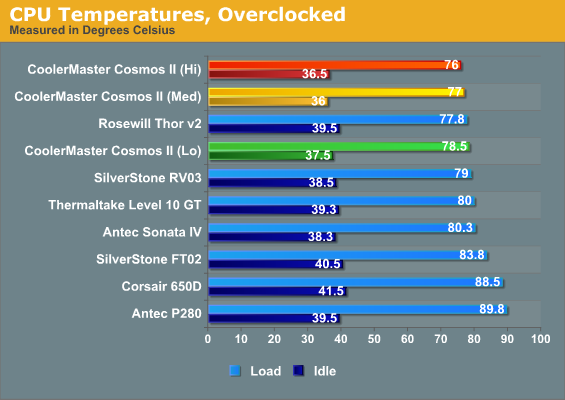
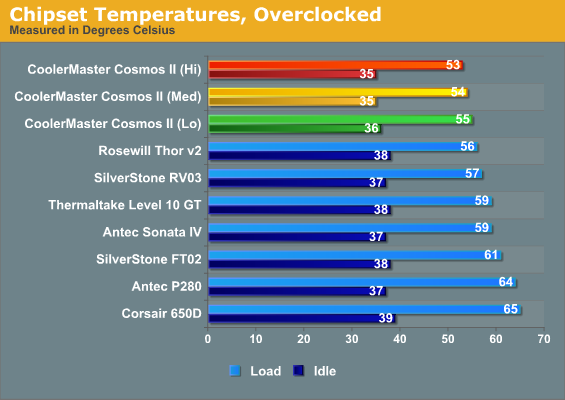
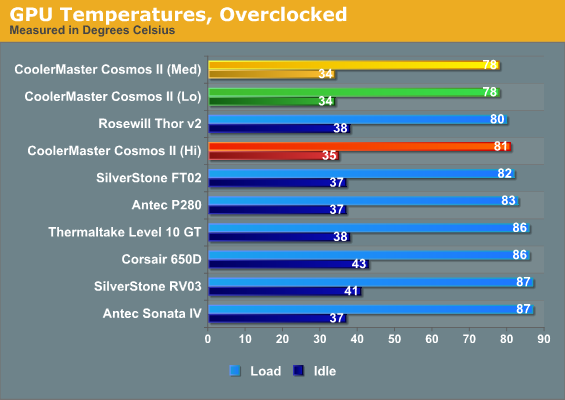
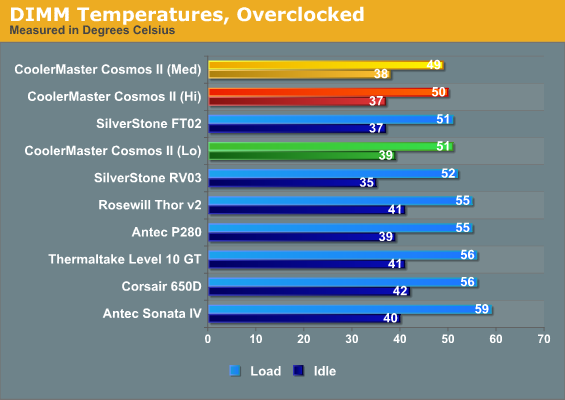

The Cosmos II continues to basically trade blows with Rosewill's enclosure, but the medium fan setting continues to be the ideal choice. That said, remember that the Thor v2 also includes fan controls; we tested them at minimum and maximum speeds (minimum speed performance is presented here), but if you're willing to tweak them a little odds are good you can hit the same thermal performance.
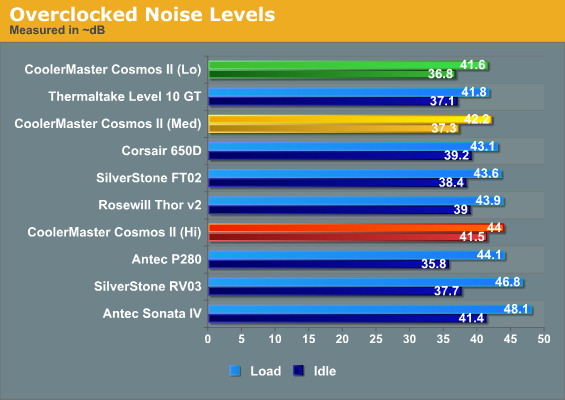
We can't really argue with these numbers, though. The medium fan setting is definitely where it's at for the Cosmos II, at least in its stock configuration. Cooling performance is superior all around, with noise levels to match. The high fan setting is next to useless.










53 Comments
View All Comments
JarredWalton - Monday, January 23, 2012 - link
I assumed Dustin meant something more like a steel frame for the doors and hinges, with aluminum sheeting for the main side cover. But perhaps he can clarify. :-)Death666Angel - Monday, January 23, 2012 - link
Ah, so that would mean everything that has a functional purpose is steel while the outside is an aluminum sheet. Not as I assumed just all steel with an aluminum textured surface. :-) I wouldn't mind a clarification. :DJarredWalton - Monday, January 23, 2012 - link
Chatting with Dustin, it sounds like the above is correct -- except some of the exterior is plastic as well, and the bars around the main body are steel. Actually, I think the main body is steel, the frame/inside of the doors is steel, and only the outside of the side panels is aluminum.Rick83 - Monday, January 23, 2012 - link
I have an original Stacker, and while it has its weaknesses, it's still one of the best cases when it comes to keeping a lot of HDDs installed with decent cooling or hot-plugging.While 5.25" bays are dying out, so has the Stacker died a few years ago - something that I am a bit sad about, as it's a simple, efficient, large case made from top materials. Also it comes with wheels :D
I think the Cosmos is in some way supposed to be a modern replacement for it, and while its price point is slightly elevated compared to what a stacker sold for back in the day, you do seem to get some very nice features, and decent stock fans.
Clearly, the test program is not suited to really differentiate between high end enclosures, and I'd like to see a multi-card setup, ideally of silent, open circulation cards. Radial fans are so noisy, that the noise performance of the case is directly correlated with the RPM of the GPU-fan.
Additionally, if you want to run that big radiator, the cosmos 2 becomes more of a value proposition, and it keeps the mostly restrained looks of the CM case family (with the exception of many things HAF). The lack of wheels is disturbing, as with a full complement of drives and heat sinks, you could easily hit 40 kg for the entire machine. Lugging that about is quite a chore. And the Stacker faces the same issue as the Cosmos: there's nowhere really to grab a good hold of it, especially as all the weight is where you can't grab it.
Finally, bringing a µATX-comparison isn't really apt. Firstly, SB-E is all about PCIe-lanes, which µATX negates completely. So a Gene-Z is a reasonable proposition, but X79 is what XL-ATX is made for. With X79 you want multiple graphics cards, which is where big cases come in, as usually the need arises to water cool these things, as otherwises the kW of heat coming out of four cards can't be managed - enter the 360mm radiator mounting capability.
This case has a market, and that market clearly does not comprise the reviewer - it would have been interesting to see more aspects that actually interest the targeted users, such as actually mounting that radiator, and whether the case offers rooms for pumps and reservoirs, etc. A 350$ case would never appeal to a mainstream audience.
Death666Angel - Monday, January 23, 2012 - link
We had the radiator discussion already, but if you want to cool multiple GPUs and a high end 6 core CPU quietly, you need more than this case offers. Offering one 360mm radiator space is not that impressive.For a quick reference on what cases provide that minimal kind of water cooling functionality see here: http://www.aquatuning.de/download/Gehaeuse-Radiato...
And if you talk about water cooling, the TJ07 can easily fit a 420mm radiator in the lower part of the case, it is really a common sight. :D Also, in this price range, you start bumping against caselabs cases: http://www.caselabs-store.com/cases/ which has all the radiator space you need without modding. Or you just go external solution. :D
But this case will find it's buyers.
Kristie - Thursday, January 26, 2012 - link
The Cosmos II comes with the brackets needed to take out the 6 HDD bays and install a 240mm radiator in the bottom area. There's people who've installed two 240mm radiators in there too and I don't think that'll take much modding work. The only downside is that for the 360mm radiator space at the top, there isn't enough clearance for a radiator thicker than 5cm.Risforrocket - Tuesday, January 24, 2012 - link
"I have an original Stacker...I think the Cosmos is in some way supposed to be a modern replacement for it...
Clearly, the test program is not suited to really differentiate between high end enclosures, and I'd like to see a multi-card setup, ideally of silent, open circulation cards. Radial fans are so noisy, that the noise performance of the case is directly correlated with the RPM of the GPU-fan.
Additionally, if you want to run that big radiator, the cosmos 2 becomes more of a value proposition, and it keeps the mostly restrained looks of the CM case family (with the exception of many things HAF)...
Finally, bringing a µATX-comparison isn't really apt. Firstly, SB-E is all about PCIe-lanes, which µATX negates completely. So a Gene-Z is a reasonable proposition, but X79 is what XL-ATX is made for. With X79 you want multiple graphics cards, which is where big cases come in, as usually the need arises to water cool these things, as otherwises the kW of heat coming out of four cards can't be managed - enter the 360mm radiator mounting capability.
This case has a market, and that market clearly does not comprise the reviewer - it would have been interesting to see more aspects that actually interest the targeted users, such as actually mounting that radiator, and whether the case offers rooms for pumps and reservoirs, etc. A 350$ case would never appeal to a mainstream audience."
What he said.
There is a market for this case and it's not for the smaller motherboards.
Good try, Mr. Sklavos, but not everyone want's everything small.
KoolAidMan1 - Monday, January 23, 2012 - link
I recommend "expensive" cases like the Corsairs and Silverstones, but even I have a hard time swallowing $350 for this. I'd recommend a Raven, Fortress, 800D, or 600T over this. All are great in the same ways that the Cosmos II is, but with lower price tags.ggathagan - Wednesday, January 25, 2012 - link
While I certainly agree that it's overpriced, you do have admire the sheer over-size of it.The cases you list are good cases, but none of them have have more than 8 expansion slots.
I really like my FT02, but consider it a major design flaw that they not only limited it to 7 expansion slots, but placed the 5.25" bays so close to the motherboard that you are severely restricted in your choice of optic drives.
Juddog - Monday, January 23, 2012 - link
It would be awesome to see an extended test of this case to see how it performs with the top setup with a 360mm radiator and a 240mm radiator at the bottom (with the hard drive brackets removed).